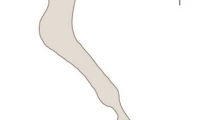Abstract
The major water bodies occurring on the Dungeness shinglecomprise the two Open Pits, which are natural in origin, and anumber of artificial gravel pits, varying from 20 to 90 yearsin age. These water bodies were found to exhibit significantvariations in salinity, from fresh water toα-oligohaline, probably for reasons of local geography.Investigation of the phytoplankton communities of these waterbodies, over a 12 month period from December 1990 to November1991, demonstrated clear seasonal fluctuations in thepopulations of many species. It also placed the water bodies inthree discrete groups which reflected mainly variations insalinity but which also suggested that the naturalness of theOpen Pits was an important factor in determining these groups.
Similar content being viewed by others
References
Bales, M., B. Moss, G. Phillips, K. Irvine & J. Stansfield, 1993. The changing ecosystem of a shallow, brackish lake, Hickling Broad, Norfolk. U.K. II. Long-term trends in water chemistry and ecology and their implications for restoration of the lake. Freshwat. Biol. 29: 141–165.
Belcher, H. & E. Swale, 1978. A beginners guide to fresh water algae. Institute of terrestrial ecology (NERC), HMSO, 47 pp.
Bellinger, E. G., 1980. A key to common British algae (fresh water). The Institutes of water engineers and scientists, London, 94 pp.
Castanier, S., M.-C. Bernet-Rollande, A. Maurin & J.-P. Perthuisot, 1993. Effects of microbial activity on the hydrochemistry and sedimentology of Lake Logipi, Kenya. Hydrobiologia 267: 99–112.
Christie, C. E. & J. P. Smol, 1993. Diatom assemblages as indicators of lake trophic status in southeastern Ontario lakes. J. Phycol. 29: 575–586.
Day, J. W. Jr., C. A. S. Hall, W. M. Kemp & A. Y. Arancibia, 1989. Estuarine Ecology. Wiley-Interscience, New York. 558 pp.
Dixit, S. S., J. P. Smol, J. C. Kingston & D. F. Charles, 1992. Diatoms–powerful indicators of environmental change. Envir. Sci. Technol. 26: 22–33.
Donaszy, E., 1959. Das Leben des Szelider Sees. Akademiai Kiado, Budapest, 425 pp.
Evans, J. H., 1972. A modified sedimentation system for counting algae with an inverted microscope. Hydrobiologia 40: 247–250.
Fangstom, I. & E. Willen, 1987. Clustering and canonical correspondence analysis of phytoplankton and environmental variables in Swedish lakes. Vegetation 71: 87–95.
Ferry, B. W. & A. Henderson, 1984. The vegetation of natural fresh water pits at Dungeness. I. Higher plants. Trans. of the Kent Field Club 9: 143–153.
Ferry, B. W. & S. J. P. Waters, 1985. Six shingle beach areas at Dungeness. Internal report for the Nature Conservancy Council, Ashford, Kent, 75 pp.
Ferry, B.W. & S. J. P. Waters, 1986. Open Pit Survey. Internal report for the Nature Conservancy Council, Peterborough, 22 pp.
Ferry B. W. & S. J. P. Waters, 1988. Natural Wetlands on Shingle at Dungeness, Kent, England. Biol. Cons. 43: 27–41.
Fritsch, F. E., 1965. Structure and Reproduction of the Algae. Volumes I & II. Cambridge University Press, Cambridge.
Fritsch, F. E., 1964, 1972, 1978. Fritsch Collection of Algal Illustrations, Parts I–III. Freshwater Biological Association. Pertti Elorante Leiden, Inter Documentation Company.
Fritsch, F. E. & P. Elorante, 1987. Fritsch Collection ofAlgal Illustrations, Part IV. Freshwater Biological Association. Pertti Elorante Leiden, Inter Documentation Company.
Greenwald, G. M. & S. H. Hurlbert, 1993. Microcosm analysis of salinity effects on coastal lagoon plankton assemblages. Hydrobiologia 267: 307–335.
Grindley, J. R., 1981. Estuarine plankton. In J. H. Day (ed.), Estuarine Ecology. A. A. Balkems: 117–146.
Hammer, U. T., 1986. The plankton communities of saline lakes. In U. T. Hammer (ed.), Saline Lake Ecosystems of the World. Dr W. Junk Publishers, Dordrecht: 171–336.
Hill, M. O., 1979. DECORANA–a FORTRAN programme for Detrended Correspondence Analysis & Reciprocal Averaging. Section of ecology and systematics. Cornell University, Ithaca, New York.
Hubbard, J. C. E., 1970. The shingle vegetation of southern England: a survey of Dungeness, Kent and Sussex. J. Ecol. 58: 713–722.
Irvine, K., B. Moss, M. Bales & D. Snook, 1993. The changing ecosystem of a shallow, brackish lake, Hickling Broad, Norfolk, U.K. I. Trophic relationships with special reference to the role of Neomysis integer. Freshwat. Biol. 29: 119–139.
Kinross, J. H., N. Christofi, P. A. Read & R. Harriman, 1993. Filamentous algal communities related to pH in streams in The Trossachs, Scotland. Freshwat. Biol. 30: 301–317.
Lund. J. W. G., C. Kipling & E. D. Le Cren, 1958. The inverted microscope method of estimating algal numbers and the statistical basis of estimation by counting. Hydrobiologia 11: 143–170.
May, V. J., 1985. Geomorphological aspects of Dungeness. In B. Ferry & S. Waters, Focus on Nature Conservation No. 12. Dungeness Ecology and Conservation. Nature Conservancy Council: 2–12.
Reuter, J. E., L. Rhodes, M. E. Lebo, M. Kotzman & C. R. Goldman, 1993. The importance of nitrogen in Pyramid Lake (Nevada, USA), a saline, desert lake. Hydrobiologia 267: 179–189.
Reynolds, D. B. H., 1986. Dungeness Foreland–its shingle ridges and what lies under them. Geogr. J. 152: 81–87.
Round, F. E., R. M. Crawford & D. G. Mann, 1990. The Diatoms. Cambridge University Press, Cambridge, 747 pp.
Royal Society for the Protection of Birds–internal reports, Dungeness, Kent.
Smayda, T. J., 1983. The Phytoplankton of Estuaries. In B. H. Ketchum (ed.), Ecosystems of the World 26. Estuaries and Enclosed Seas. Elsevier: 65–102.
The Symposium on the Classification of Brackish Waters, Venice 8–14th April, 1958. Arch. Oceanogr. Limnol. XI (Suppl).
Ter Braak C. J. F., 1988 CANOCO–a FORTRAN programme for canonical community ordination by partial detrended canonical correspondence analysis, principal components analysis and redundancy analysis (Version 2.1). Agricultural mathematics group, Wageningen.
Waters, S. J. P. & B. W. Ferry, 1989. Shingle-based wetlands at Dungeness. Bot. J. linn Soc. 101: 59–67.
Author information
Authors and Affiliations
Rights and permissions
About this article
Cite this article
Chapman, B.R., Ferry, B.W. & Ford, T.W. Phytoplankton communities in water bodies at Dungeness, U.K.: analysis of seasonal changes in response to environmental factors. Hydrobiologia 362, 161–170 (1997). https://doi.org/10.1023/A:1003190702786
Issue Date:
DOI: https://doi.org/10.1023/A:1003190702786




